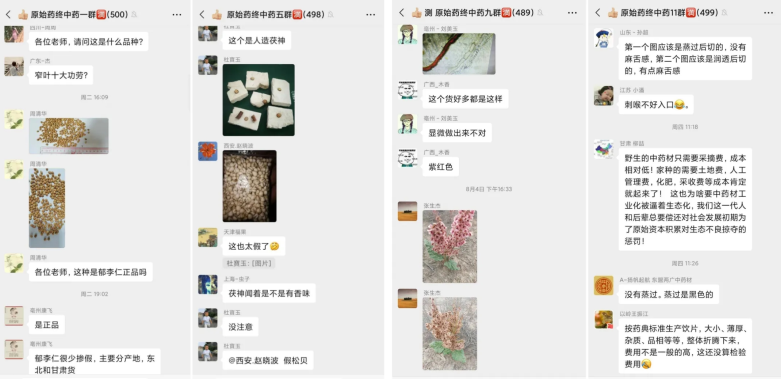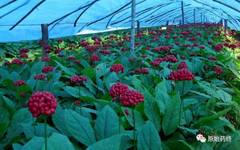Below is the standard information you searched for regarding the herb Ginseng.
Ginseng Plant
Underwood Ginseng
Cultivated Ginseng
Ginseng Slices

Below is the 2020 version of the Chinese Pharmacopoeia standard
Ginseng
RenshenGINSENG RADIX ET RHIZOMAThis product is the dried root and rhizome of the plant Panax ginseng C.A.Mey., belonging to the Araliaceae family. It is harvested in autumn, cleaned, and then sun-dried or dried by other means. The cultivated variety is commonly known as “Cultivated Ginseng“; the variety that grows naturally in the wild is referred to as “Underwood Ginseng“, and is often called “Seed Sea“.【Properties】 The main root is spindle-shaped or cylindrical, measuring 3~15cm, with a diameter of 1~2cm. The surface is grayish-yellow, with sparse, shallow, discontinuous coarse transverse wrinkles and obvious longitudinal folds. The lower part has 2~3 lateral roots, and numerous long fibrous roots, which often have inconspicuous small warty protrusions. The rhizome (bulb) is 1~4cm long, with a diameter of 0.3~1.5cm, often twisted and curved, with adventitious roots (fibrous) and sparse, pit-like stem scars (bulb scars). The texture is relatively hard, with a pale yellow-white cross-section, showing a powdery appearance, and the cambium layer has brownish-yellow ring patterns. The bark contains yellow-brown dotted resin ducts and radial fissures. The aroma is distinctive, with a slightly bitter and sweet taste.Alternatively, the main root may be approximately equal in length to or shorter than the rhizome, appearing cylindrical, angular, or Y-shaped, measuring 1~6cm. The surface is grayish-yellow, with longitudinal wrinkles, and the upper or middle-lower part has ring patterns. The lateral roots are mostly 2~3 in number, with few and long fibrous roots, clearly defined, with more pronounced warty protrusions. The rhizome is slender, with few thick and short parts, and the upper-middle part has sparse or dense, deeply sunken stem scars. The adventitious roots are thinner and mostly drooping.【Identification】 (1) The cross-section of this product shows a layer of cork cells. The inner cork layer is narrow. The outer side of the phloem has fissures, while the inner side has tightly arranged parenchyma cells, with scattered resin ducts containing yellow secretions. The cambium forms a ring. The xylem rays are broad, with vessels scattered singly or in groups, intermittently arranged in a radial pattern, and occasionally non-lignified fibers adjacent to the vessels. The parenchyma cells contain calcium oxalate cluster crystals.The powder is pale yellow-white. Fragments of resin ducts are easily seen, containing yellow block-like secretions. The calcium oxalate cluster crystals have a diameter of 20~68μm, with sharp angles. The cork cells appear square or polygonal, with wavy walls. The reticulated vessels and spiral vessels have a diameter of 10~56μm. Starch grains are abundant, with single grains being spherical, semi-spherical, or irregularly polygonal, measuring 4~20μm, with hilum points being dot-like or fissured; compound grains consist of 2~6 single grains.(2) Take 1g of the powdered product, add 40ml of chloroform, and heat under reflux for 1 hour. Discard the chloroform solution, dry the residue, add 0.5ml of water to moisten, add 10ml of saturated n-butanol, and treat with ultrasound for 30 minutes. Collect the supernatant and add 3 times the volume of ammonia test solution, shake well, let it stand to separate, evaporate the upper layer to dryness, dissolve the residue in 1ml of methanol to prepare the test solution. Also take 1g of ginseng reference material and prepare the reference solution in the same manner. Then take reference samples of ginsenosides Rb1, Re, Rf, and Rg1, and prepare a mixed solution containing 2mg of each per 1ml in methanol as the reference solution. Perform thin-layer chromatography (General Rule 0502) test, taking 1~2μl of each of the three solutions and spotting them on the same silica gel G thin-layer plate, using the lower layer solution of chloroform-ethyl acetate-methanol-water (15:40:22:10) placed below 10℃ as the developing agent. Develop, remove, dry, and spray with 10% sulfuric acid ethanol solution, heating at 105℃ until spots are clearly visible, and inspect under sunlight and ultraviolet light (365nm). In the test solution, corresponding spots of the same color or fluorescent spots should appear in the same positions as those in the reference material and reference solution.【Inspection】 Moisture must not exceed 12.0% (General Rule 0832, Method 2).Total Ash must not exceed 5.0% (General Rule 2302).Heavy Metals and Harmful Elements should be determined according to the methods for lead, cadmium, arsenic, mercury, and copper (General Rule 2321, atomic absorption spectrophotometry or inductively coupled plasma mass spectrometry), with lead not exceeding 5mg/kg; cadmium not exceeding 1mg/kg; arsenic not exceeding 2mg/kg; mercury not exceeding 0.2mg/kg; copper not exceeding 20mg/kg.Other Organic Chlorine Pesticide Residues should be determined by gas chromatography (General Rule 0521).Chromatographic conditions and system suitability test Analysis column: bonded cross-linked 14% cyano-propyl phenyl dimethyl siloxane as the stationary phase (DM1701 or similar type) capillary column (30m×0.32mm×0.25μm), verification column: bonded cross-linked 5% phenyl methyl siloxane as the stationary phase (DB5 or similar type) capillary column (30m×0.32mm×0.25μm);63Ni-ECD electronic capture detector; injection port temperature 230℃, detector temperature300℃, non-split injection. Program temperature rise: initial temperature 60℃, hold for 0.3 minutes, increase to 170℃ at a rate of 60℃ per minute, then increase to 220℃ at a rate of 10℃ per minute, hold for 10 minutes, then increase to 240℃ at a rate of 1℃ per minute, and finally increase to 280℃ at a rate of 15℃ per minute, holding for 5 minutes. Theoretical plate number calculated based on the α-BHC peak should not be less than 1×105, and the separation degree of two adjacent chromatographic peaks should be greater than 1.5.Preparation of mixed reference solution Weigh appropriate amounts of pentachloronitrobenzene, hexachlorobenzene, heptachlor (heptachlor and epoxide heptachlor), chlordane (cis-chlordane, trans-chlordane, oxidized chlordane) pesticide reference materials, dissolve in n-hexane to prepare a solution containing approximately 100μg per 1ml. Accurately measure 1ml of the above reference solution, place it in the same 100ml volumetric flask, add n-hexane to the mark, shake well; or accurately measure 1ml of the mixed organic chlorine pesticide reference solution, place it in a 10ml volumetric flask, add n-hexane to the mark, shake well to obtain (each 1ml contains 1μg of each pesticide reference material).Preparation of mixed reference solution Accurately measure the above mixed reference stock solution, using n-hexane to prepare solutions containing 1ng, 2ng, 5ng, 10ng, 20ng, 50ng, 100ng per 1ml.Preparation of test solution Take the product, grind it into a fine powder (through a No. 2 sieve), take about 5g, accurately weigh, place it in a stoppered conical flask, add 30ml of water, shake for 10 minutes, accurately add 50ml of acetone, weigh, treat with ultrasound (power 300W, frequency 40kHz) for 30 minutes, cool, reweigh, use acetone to make up for the weight loss, then add about 8g of sodium chloride, accurately add 25ml of dichloromethane, weigh, treat with ultrasound (power 300W, frequency 40kHz) for 15 minutes, reweigh, use dichloromethane to make up for the weight loss, shake to fully dissolve sodium chloride, let it stand, transfer to a centrifuge tube, centrifuge (3000 rpm) for 3 minutes to completely separate, transfer the organic phase to a stoppered conical flask containing an appropriate amount of anhydrous sodium sulfate, and let it stand for 30 minutes. Accurately measure 15ml, place it in a water bath at 40℃ under reduced pressure to concentrate to about 1ml, add about 5ml of n-hexane, concentrate under reduced pressure to near dryness, dissolve in n-hexane and transfer to a 5ml volumetric flask, dilute to the mark, shake well, transfer to a centrifuge tube, and slowly add sulfuric acid solution (9→10) 1ml, shake for 1 minute, centrifuge (3000 rpm) for 10 minutes, collect the supernatant, add 1ml of water, shake, and take the supernatant to obtain.Determination method Accurately take 1μl of the test solution and the corresponding concentration of the mixed reference solution, inject into the gas chromatograph, and continuously sample three times, taking the average of the three values, and calculating by the external standard method.The product must not contain more than 0.1mg/kg of pentachloronitrobenzene; not more than 0.1mg/kg of hexachlorobenzene; not more than 0.05mg/kg of heptachlor (the sum of heptachlor and epoxide heptachlor); not more than 0.1mg/kg of chlordane (the sum of cis-chlordane, trans-chlordane, and oxidized chlordane).【Content Determination】 Should be determined by high-performance liquid chromatography (General Rule 0512).Chromatographic conditions and system suitability test Using octadecyl silane bonded silica gel as the filler; acetonitrile as mobile phase A, and water as mobile phase B, performing gradient elution according to the specifications in the table below; detection wavelength is 203nm. The theoretical plate number calculated based on the ginsenoside Rg1peak should not be less than 6000.
| Time (minutes) | Mobile PhaseA(%) | Mobile PhaseB(%) |
| 0~35 | 19 | 81 |
| 35~55 | 19→29 | 81→71 |
| 55~70 | 29 | 71 |
| 70~100 | 29→40 | 71→60 |
Preparation of reference solution Accurately weigh ginsenoside Rg1reference, ginsenoside Re reference, and ginsenoside Rb1reference, and prepare a mixed solution containing 0.2mg of each per 1ml in methanol, shake well to obtain.Preparation of test solution Take about 1g of the powdered product (through a No. 4 sieve), accurately weigh, place it in a Soxhlet extractor, add chloroform, and heat under reflux for 3 hours. Discard the chloroform solution, dry the residue, and transfer it along with the filter paper into a 100ml conical flask. Accurately add 50ml of water-saturated n-butanol, seal tightly, let it sit overnight, treat with ultrasound (power 250W, frequency 50kHz) for 30 minutes, filter, discard the initial filtrate, accurately measure 25ml of the continued filtrate, place it in an evaporation dish to evaporate to dryness, dissolve the residue in methanol, and transfer to a 5ml volumetric flask, diluting to the mark, shaking well, and filtering to obtain the continued filtrate.Determination method Accurately take 10μl of the reference solution and 10~20μl of the test solution, inject into the liquid chromatograph for determination.The product must contain ginsenoside Rg1(C42H72O14) and ginsenoside Re(C48H82O18) totaling not less than 0.30%, and ginsenoside Rb1(C54H92O23) not less than 0.20%.Herbal Slices【Preparation】 Moisten thoroughly, cut into thin slices, dry, or grind and crush when used.Ginseng Slices This product appears as round or oval thin slices. The outer skin is grayish-yellow. The cut surface is pale yellow-white or whitish, showing a powdery appearance, with the cambium layer having brownish-yellow ring patterns. The bark contains yellow-brown dotted resin ducts and radial fissures. It is light in weight and brittle. The aroma is distinctive, with a slightly bitter and sweet taste.【Content Determination】 Similar to the herb, containing ginsenoside Rg1(C42H72O14) and ginsenoside Re(C48H82O18) totaling not less than 0.27%, and ginsenoside Rb1(C54H92O23) not less than 0.18%.【Identification】 (except for the cross-section) 【Inspection】 Similar to the herb.【Taste and Meridian Affinity】 Sweet, slightly bitter, slightly warm. It enters the Spleen, Lung, Heart, and Kidney meridians.【Functions and Indications】 Greatly tonifies the original Qi, restores the pulse, stabilizes collapse, tonifies the Spleen and benefits the Lung, generates fluids and nourishes the blood, calms the spirit and benefits intelligence. Used for deficiency of Qi leading to collapse, cold limbs and weak pulse, Spleen deficiency with poor appetite, Lung deficiency with cough and wheezing, fluid damage with thirst, internal heat with diabetes, deficiency of Qi and blood, prolonged illness with weakness, palpitations and insomnia, impotence and cold uterus.【Dosage and Administration】 3~9g, decocted separately for administration; it can also be powdered and taken, with a single dose of 2g, twice a day.【Precautions】 Should not be used in conjunction with Li Lu or Wu Ling Zhi.【Storage】 Store in a cool, dry place, sealed to prevent pests.Grow together with 100,000 TCM enthusiasts in WeChat groups👇👇👇

Scan the QR code below to quickly join the original herbal group on WeChat


